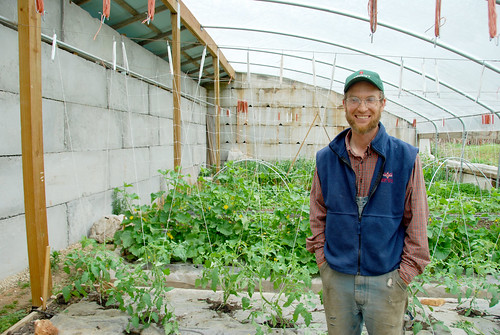
Curtis Millsap works in the Chinese High Tunnel on his southwestern Missouri farm. NRCS photo.
You can get just about anything you want at Millsap Farms, including an education about market farming.
Curtis Millsap estimates that he, his family and a crew of interns feed about 200 families on 2.5 acres of his 20-acre farm near Springfield, Mo. While another seven acres of the farm sometimes includes sheep, poultry and cattle, it’s the vegetable operation that supports Millsap, his wife Sarah and their nine young children.
Millsap uses two greenhouses and three seasonal high tunnels to grow produce year-round.
High tunnels are plastic-covered structures that enable farmers to lengthen the growing season by using the sun’s heat to regulate temperature inside.
Millsap sells through the Farmers Market of the Ozarks and to 75-100 community supported agriculture, or CSA, customers. In a CSA, people buy shares of the farm, and in return they receive a portion of the harvest when in season.
One of Millsap’s high tunnels is a Chinese high tunnel, which he built with funding through a Conservation Innovation Grant from the USDA’s Natural Resources Conservation Service (NRCS). Previously, Millsap received financial assistance from NRCS to install a conventional seasonal high tunnel through NRCS’ Environmental Quality Incentives Program.
Missouri is home to hundreds of seasonal high tunnels, including nearly 500 funded by NRCS, but Millsap’s Chinese high tunnel is the only one in Missouri, and one of only a few in the United States. Millsap received $20,000 from a $50,000 Conservation Innovation Grant (CIG) awarded to the Watershed Committee of the Ozarks to build the Chinese high tunnel, pay for energy renovations in other greenhouses and to establish a grazing system.
This grant program helps groups demonstrate innovative approaches to improve soil quality, air quality, and water quality, conserve energy, and enhance wildlife habitat in balance with productive agricultural systems.
The committee wanted to demonstrate the benefits of the Chinese high tunnel, which differs from other seasonal high tunnels in that one of the long sides of the 23-by-70-foot structure and both short ends are heavily insulated with concrete and soil.
“One of the things the CIG did was improve our efficiency in the high tunnel,” Millsap said. “It is warmer in the morning and warmer in the evening (in the Chinese high tunnel) than in the other greenhouses. But what’s interesting is that midday, it is cooler in there than in the other greenhouses. This thing never spikes. It has a smooth curve, which is better for plants.”
Millsap said the different design is popular in China, where energy is expensive and labor is cheap.
“I was looking into the future and thinking that energy is not going to get cheaper, so it made sense,” Millsap said. “And this is a teaching farm, so I have the workers.”
Millsap’s workers include seven apprentices who are compensated with room, board, a farming education and a stipend.
“These are people who seriously want to experience this and see if they want to be farmers,” Millsap said. “We’ve been doing this for seven years. I’ve had 20 apprentices, and seven are still actively involved in agriculture.”
The farm also serves as a site for farm tours and other community events, all intended to further the buy-local movement. High tunnels are a cornerstone of USDA’s Know Your Farmer, Know Your Food Initiative, which coordinates USDA’s work on local and regional food systems. Since 2009, through NRCS, USDA has provided assistance to help producers construct over 13,000 high tunnels on farms around the country.
“We have this great promotion in ‘buy local,’ but that will go away if we can’t meet demand,” Millsap said. “We try to get as many people out to the farm as we can, show them what farming is about, maybe get their hands dirty.”
Not raised on a farm, Millsap said he learned to farm by attending conferences, by reading and by visiting with lots of other farmers. He said it was something he found himself called to do.
“It’s not something I was looking to do, but sometimes when you are called, you better listen,” he said.
No comments:
Post a Comment